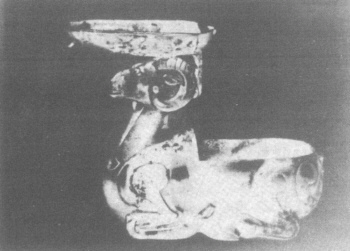Chapter 5 Section 2 Qin and Han Works Focusing on Object Modeling
From the Three Dynasties to the Qin and Han Dynasties, bronze wares have entered a new era.The dignified, magnificent, and fantasy styles of the past have disappeared, replaced by some unpretentious, ingeniously designed, simple and not monotonous styles.The incomparable heavy objects (ceremonial vessels, sacrificial vessels, etc.) that used to be symbols of royal power and theocracy were also obliterated by a wide variety of household objects.This new style of bronze ware actually started in the Warring States Period, but it became the mainstream in the Qin and Han Dynasties.In the early Qin and Western Han Dynasties, daily-use bronzes had become the mainstream. However, under the premise of adapting to the needs of life, the curves and flowing patterns, gold-plated, silver-plated, gold and silver inlaid patterns, and gemstone inlaid patterns used in the Warring States Period continued. It has been widely used and developed, making the decoration of bronze wares in this period rich and colorful.After the mid-Western Han Dynasty, complex patterns and rich decorations on bronzes became less and less common, and bronzes with plain surfaces became popular.The bronze ware went down the temple and returned to life.These daily-use bronze wares that basically do not need decorations are called plain wares.The Han Dynasty was the period with the highest achievements in the production of plain wares.These bronze ware pay attention to and pay attention to the shape of the vessel; they are works of art combining science and technology with plastic arts.For example, the Changxin Palace Lantern unearthed in 1968 in the tomb of Dou Wan (Wan Wan), the wife of Liu Sheng's wife, Zhongshan King Jing of the Western Han Dynasty in Mancheng, Hebei, is a real-life item.The whole shape is like a court lady kneeling and holding a lamp.The whole body of the court lady is gilded, with clear facial features, full face, leisurely demeanor, and vivid and lifelike shape.The whole device is divided into six parts: head, body, right arm, lamp holder, lamp panel and lampshade.The palace lady holds the lamp panel with her left hand, raises her right arm high, and pinches the lamp cover with her hand.The lamp panel can be rotated.The lampshade is two tile-shaped panels, which can be opened and closed, so that the direction of light and the intensity of illumination can be adjusted at will.The right arm and body of the court lady are hollow, and the soot from the lamp enters the body through the right arm, thus keeping the room clean.The design of Changxin Palace Lantern is flexible and reasonable, the figure structure is scientific, practical and aesthetic, and it is a very representative piece of bronze daily necessities in the Han Dynasty.The bronze sheep lamp unearthed from Liu Sheng's tomb is also a delicately designed work of art.When the lamp is not in use, it is a bronze sculpture of a sheep. When the back cover is lifted and supported on the head, it becomes a lamp.From the copper sheep lamp, once again we can see the ingenious design ideas and superb production methods of the Han people. (Picture 6) Others such as bull lanterns, bear lanterns, goose fish lanterns, red bird lanterns, bamboo festival lanterns, etc. are the same as Changxin Palace Lanterns. They are exquisite and refined in shape, simple and reserved; vivid and friendly in visual effect; functional Clever and practical.In addition, various furnaces, kettles, plates, etc. also reflect these characteristics.The Han Dynasty, which produced a large number of plain utensils, was not an era that did not pursue ornamentation. On the contrary, people in the Han Dynasty were consistent in their pursuit of beauty.With the recovery of the economy and the strengthening of the national power after the rule of Wenjing, the trend of beautiful decoration has intensified from the ruling class.This kind of atmosphere can be seen in the carvings and paintings of palaces, halls, tomb walls, coffins, etc., in the gorgeous and exquisite lacquerware and clothing, in the dazzling gold and silver interlocking decorations, and in the craftsmanship of gold, jade, and colored glaze. see.In this colorful environment, the unpretentious style of the bronzes has its own unique beauty.Among the bronze wares of the Han Dynasty, the bronze mirror is a very special variety, which is a unity of simplicity and beauty, practicality and art.Its mirror surface is clean and bright, spotless; its mirror back relief is exquisite, extremely ingenious conception.This bronze mirror, which combines simple and traditional styles, reflects the compatibility of the Han Dynasty people with ancient culture and their own innovation.

Figure 6 Bronze Sheep Lantern Unearthed in Mancheng, Hebei Province, Western Han Dynasty

Figure 6 Bronze Sheep Lantern Unearthed in Mancheng, Hebei Province, Western Han Dynasty
